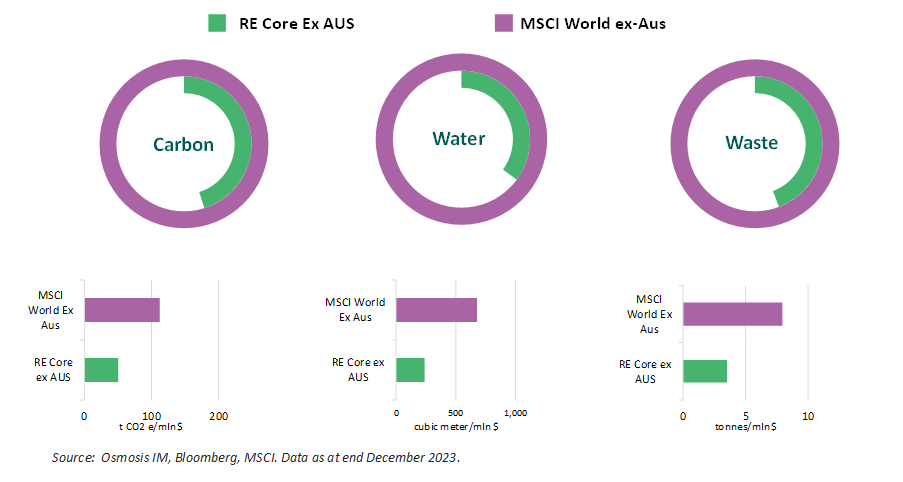Since its inception three years ago the Strategy has outperformed its benchmark, from both a financial and an environmental perspective.
Investment literature is awash with studies asking whether ‘environmentally friendly’ (or ‘green’) portfolios can be operated without incurring a financial penalty. The Osmosis Resource Efficient Core Equity (ex-Aus) Strategy has demonstrated positive returns relative to the MSCI World (ex-Aus) benchmark since its launch in December 2020 (see full performance) while significantly reducing the environmental footprint of the portfolio.
Over the 3 years since its inception, the Core Equity ex Australia strategy has delivered an annualised net return of 12.64%, outperforming the MSCI World ex Australia Index by 0.87% per annum while simultaneously reducing investors’ ownership of Carbon, Water, and Waste by an average of 63%.* This has resulted in a strong information ratio of 1.47 since inception. The majority of this active return has been delivered by the Osmosis proprietary stock-specific/idiosyncratic factor which we attribute back to our overweight exposure to resource-efficient companies, whilst maintaining underlying common factor exposures that tightly track those of the MSCI World ex Australia (AUD) benchmark. The strategy’s assets under management have increased to over $1.8 billion USD through new investments and market moves (as of 31 December 2023).

A unique sustainable factor based on Resource Efficiency
Identification of corporate Resource Efficiency as an uncorrelated sustainable alpha signal which we believe is unique to Osmosis.
The Resource Efficient Core Equity (ex-Australia) Strategy was designed for the Australian pension fund market following the success of the Osmosis Resource Efficient Core Equity Fund. The Core Equity Strategies are the product of extensive research, correlation and attribution analysis on our proprietary Resource Efficiency Factor. Developed over 12 years, our proprietary and objective environmental research process has enabled the identification of companies that are better placed to deal with the increasing number of environmental challenges that lie ahead. At the same time, those companies that refuse to change or are too slow to adapt will continue to destroy shareholder value.
Managing active & environmental risk
All portfolios seeking a sustainable outcome will naturally bring in active risk relative to a market-cap-weighted benchmark. The Osmosis program is unique in that the active risk is controlled and targeted towards a sustainable Resource Efficient alpha signal.
Our goal with the Core Strategy was to ensure that the allocated risk budget was not left unrewarded as investors sought to reduce their portfolio’s environmental footprints. Our core strategies aim to deliver better risk-adjusted returns than their respective benchmarks by tilting the portfolio towards stocks we have identified as more resource-efficient and thus more likely to outperform their sector peers. All the strategies deliver the main benefits of index investing by offering a highly diversified and cost-efficient portfolio.
Research has evidenced that Resource Efficiency is a return signal independent from traditional country, sector, size and style factors. The allocated risk budget is targeted towards resource efficiency through the idiosyncratic part of the risk models, risk that is usually diversified away. Through this smarter management of the active risk, the core strategy offers the potential to replace the MSCI World ex AUS index in a passive portfolio without impacting existing exposures and may enhance the risk-adjusted return.
A broad economy approach
When we launched in 2009, we were one of the first sustainable asset managers to focus on a broad economy solution. We recognised that addressing supply was only meaningful in the context of addressing demand. This Strategy was developed to appeal to investors from institutions to individuals who shared our conviction that a well-diversified global portfolio, targeting overweight and underweight positions to environmentally efficient and inefficient companies across the broader economy, would result in improved portfolio returns and meaningful environmental outcomes.
A significant environmental impact
The outcome of this sophisticated core replacement strategy is a significant reduction in the portfolio’s environmental footprint. The Strategy delivers significant reductions in ownership of Carbon (55%), Water (65%) and Waste (56%) relative to the benchmark while remaining invested across the broader economy (Data as of 31 December 2023).
Osmosis believes that the planet’s long-term sustainability demands a re-evaluation of overall resource consumption. Carbon, Water, and Waste are subject to increasing regulation, cost pressure, and social scrutiny. Companies focused on environmental impact need to address those aspects of consumption and pollution that are most relevant to their business model, which will often include the mitigation of resources in addition to Carbon. Osmosis’ research demonstrates that this three-factor approach also delivers a more reliable investment signal.
Important Information
* The foot printing metrics above have been calculated using a Total Metrics approach, apportioning carbon emissions, water consumption and waste generation to the investor based on an equity ownership perspective. Calculating the “owned” emissions, water and waste from each position in the portfolio and benchmark, and adding those metrics yields the total impacts for the portfolio. The calculations have been based on metrics recorded in the MoRE DataBase where available, and industry averages have been used to estimate any gaps in the data coverage.
Performance. NO REPRESENTATION IS BEING MADE THAT ANY ACCOUNT WILL OR IS LIKELY TO ACHIEVE PROFIT OR LOSSES SIMILAR TO THOSE SHOWN.
An investor’s actual account is managed by Osmosis based on the strategy, but the actual composition and performance of the account may differ from those of the strategy due to differences in the timing and prices of trades, and the identity and weightings of securities holdings.
Past performance may not be indicative of future results. Different types of investments and/or investment strategies involve varying levels of risk, and there can be no assurance that any specific investment or investment strategy will be profitable. No current or prospective client should assume that future performance will be profitable, equal the performance results reflected, or equal any corresponding historical benchmark index. For reasons including variances in fees, differing client investment objectives and/or risk tolerance, market fluctuation, the date on which a client engaged Osmosis’s services, and any account contributions or withdrawals, the performance of a specific client’s account may have varied substantially from the referenced performance results. In the event that there has been a change in a client’s investment objectives or financial situation, the client is encouraged to advise us immediately. It is important to remember that the value of investments, and the income from them, can go down as well as up and is not guaranteed and that you, the investor, may not get back the amount originally invested. Any forecast, projection or target where provided is indicative only and is not guaranteed in any way. Osmosis accepts no liability for any failure to meet such forecast, projection or target. Past performance is not an indication of future performance.
Net Performance. Net returns are net of fees and in USD unless indicated otherwise. Net returns are net of fees, costs and dividend withholding tax. Different fees may apply to a client’s account and a client’s returns may be further reduced by the advisory fee and other expenses incurred in the management of its account. Please see the specific performance disclosure under each slide for additional details. Our fees are fully disclosed in Part 2A of Form ADV and may be updated from time to time.
The historical index performance results for all benchmark indexes do not reflect the deduction of transaction, custodial, or management fees, the incurrence of which would have the effect of decreasing indicated historical performance results. Indexes are unmanaged and are not available for direct investment. The historical performance results for all indices are provided exclusively for comparison purposes only, and may or may not be an appropriate measure to provide general comparative information to assist an individual client or prospective client in determining whether Osmosis performance meets, or continues to meet, his/her investment objective(s). The referenced benchmarks may or may not be appropriate benchmarks against which an observer should compare our returns. The MSCI World ex Australia Index captures large and midcap representation across 22 of 23 Developed Markets (excluding Australia).



